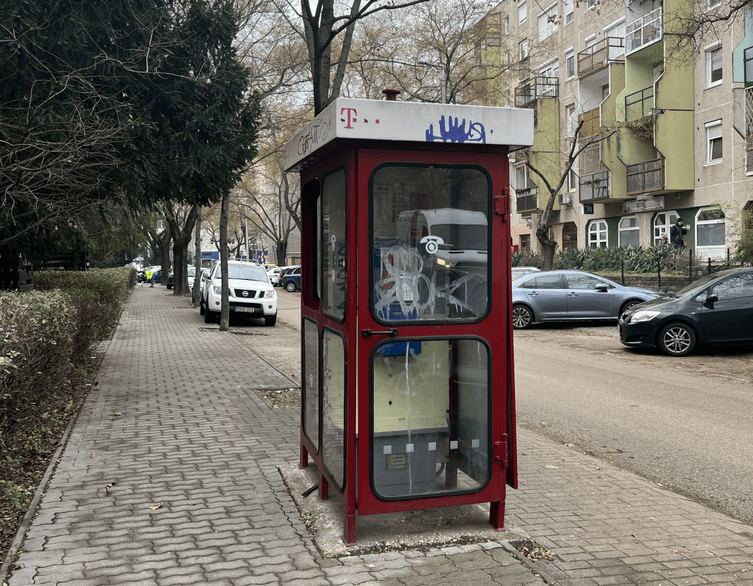The Phone Booth Cleanup: Budapest Removes Urban Relics

Walk through almost any neighborhood in Budapest, and you’ve likely noticed them—weathered phone booths with shattered glass, peeling paint, and layers of graffiti. Once vital pieces of urban infrastructure, these relics of the pre-mobile era have been slowly decaying on street corners for years, serving no purpose beyond visual clutter. Now, after a unanimous vote by the Budapest City Council on October 29, that’s finally about to change.
Councilman Vitézy Dávid’s proposal to remove hundreds of abandoned and unused phone booths from the city’s streets has been approved, marking the beginning of a long-overdue cleanup. As Vitézy announced on social media, “Budapest’s streets have been marred by hundreds of abandoned, broken-glass, graffiti-covered phone booths—but now this era may finally come to an end.”
From Essential Infrastructure to Urban Eyesores
Phone booths were once indispensable. Before the explosion of mobile phones in the late 1990s and early 2000s, they were lifelines for communication—especially for travelers, tourists, and residents without home phones. In Budapest, as in cities worldwide, phone booths dotted street corners, transit hubs, and public squares. They offered a sense of connection and security in an analog world.
But technology moved on, and the booths didn’t. As smartphones became ubiquitous, the need for public phones evaporated almost overnight. Companies stopped maintaining them. Vandalism took over. Glass panels shattered. Graffiti accumulated. What was once modern infrastructure became an abandoned reminder of a bygone era. Many booths haven’t functioned in years, yet they’ve remained on Budapest’s sidewalks—neglected, forgotten, and increasingly out of place in a city working hard to modernize its public spaces.
A Comprehensive Survey and Removal Plan
The newly approved resolution sets a clear timeline. By spring 2026, the city will complete a comprehensive survey documenting exactly how many phone booths exist in Budapest, who is responsible for maintaining them, what condition they’re in, and whether anyone still uses them. The findings will inform a citywide strategy for removal, focusing first on booths in the worst condition and those no longer serving any public function.
In areas directly managed by the city, removal can begin immediately for booths that have been officially released from their service obligations. This means that over the coming months, residents and visitors will start seeing these derelict structures disappear from street corners, replaced—hopefully—by cleaner, more useful urban furniture like benches, bike racks, or flower planters.
The proposal also includes recommendations for amending relevant regulations, making it easier and faster to dismantle non-functional booths without bureaucratic delays. This legislative update is crucial, as outdated rules have often prevented cities from removing infrastructure that no longer serves a purpose.
Best deals of Budapest
Why This Matters for Visitors and Residents Alike
For tourists exploring Budapest, the removal of abandoned phone booths might seem like a small detail, but it reflects a broader commitment to urban quality and aesthetics. Cities are defined not just by their grand monuments and historic sites, but by the everyday details—the cleanliness of sidewalks, the functionality of public spaces, and the care taken to remove what no longer works.
Clean, well-maintained streets enhance the visitor experience. They make neighborhoods feel safer, more welcoming, and more pleasant to walk through. Removing decaying infrastructure also signals that the city is actively investing in its future rather than clinging to obsolete remnants of the past.
For residents, the change is even more significant. These booths have become symbols of neglect—proof that something broken can sit untouched for years. Their removal demonstrates that city leadership is listening and willing to act on quality-of-life issues that affect daily life.
A Glimpse Into Budapest’s Modernization Efforts
The phone booth cleanup is part of a larger trend in Budapest’s urban development. Over recent years, the city has undertaken numerous projects aimed at improving public spaces—from the redesign of Blaha Lujza Square to the expansion of green courtyard initiatives and the introduction of square attendants who maintain cleanliness and order. Each of these efforts contributes to a shared vision: a Budapest that honors its history while embracing contemporary standards of livability and beauty.
As the survey progresses and removal begins, the question will shift from “what do we get rid of?” to “what do we put in its place?” Will the freed-up space become seating areas, charging stations for electric bikes, or small green installations? The answer will depend on neighborhood needs and community input, but the opportunity is clear: Budapest has a chance to turn hundreds of wasted spaces into something useful.
Nostalgia Meets Progress
There will undoubtedly be some nostalgia for phone booths. They carry cultural weight—featured in films, songs, and memories of a slower, more analog era. Some cities have preserved iconic booths as historical artifacts or repurposed them creatively as mini libraries, art installations, or charging stations. Whether Budapest will follow a similar path for a select few remains to be seen.
But for the vast majority of these structures—broken, non-functional, and aesthetically degraded—the time has come to say goodbye. Their removal isn’t about erasing history; it’s about making room for a city that works better for everyone who lives in, visits, or passes through it.
By spring 2026, Budapest’s streets will look noticeably different. Cleaner. More streamlined. More focused on the present and future rather than the relics of the past. And for travelers exploring the city, that means a more enjoyable, polished urban experience—one phone booth removal at a time.
















